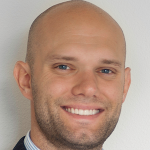Amina AlTai is an executive coach, leadership trainer, and chronic illness advocate. She has partnered with companies such as Google, Snap, Outdoor Voices, Chief, and Roku, and been featured in goop, Forbes, Well+Good, NBC, CBS, and the New York Times. She is an Entrepreneur Magazine expert-in-residence, Forbes contributor, and was named one of Success Magazines Women of Influence.
What’s the big idea?
The Ambition Trap gives you greater permission to reclaim ambition on your own terms. Most of us think ambition means doing everything in our power to get what we want, but this approach comes at the price of health, well-being, and upholds oppressive systems. Ambition itself is not a dirty word—we can renegotiate unhealthy assumptions about ambition to engage with it in meaningful and restorative ways. To escape the trap of an endless cycle of overwork that is never enough, ambition must be anchored in our purpose rather than our pain.
Below, Amina shares five key insights from her new book, The Ambition Trap: How to Stop Chasing and Start Living. Listen to the audio version—read by Amina herself—below, or in the Next Big Idea App.
1. We need to redefine ambition.
Most of us only know ambition in a dysfunctional sense: a relentless desire to succeed, regardless of the cost. For me to win, someone else must lose, we think. But that’s not ambition. Ambition itself is natural and neutral. In its purest form, it’s a desire for more life. It’s a wish to unfold, evolve, and flourish.
Grass wants to grow; trees like to stretch toward the sun; we all want to thrive. The essence of all living beings is to be motivated for more, and as humans, we’re the only species that has a choice in how we direct that advancement. So, we must be great stewards of it. Things go sideways when our striving begins to cost us and others health, relationships, peace of mind, and sense of self. This isn’t ambition in its neutral, natural form, but in its most painful.
2. There are two types of ambition.
Though ambition in and of itself is neutral and natural, there are two ways we usually see it unfold. It can either be painful ambition or purposeful ambition. Painful ambition is the voracious desire to advance, regardless of the costs.
Painful ambition has a few trademarks:
- Unaware of the systems that shape us
- A narrow mindset
- Driven to win at all costs
- Focus on individualism and hoarding power
- Instrumentalization of yourself and others
- Toxic positivity
- Self-imposed urgency
Most of us believe that embodying these characteristics means we’re being ambitious. But we’re actually displaying painful ambition. Painful ambition is driven by our core wounds. According to Lise Bourbeau, those wounds are rejection, abandonment, humiliation, betrayal, and injustice. For each wound we have, we wear a corresponding mask. A rejection wound wears the mask of avoidance. A betrayal wound wears the mask of control. Every one of us emerges from our formative years with an injury of the psyche. It’s a human right or passage, even if you come from the best family in the world. When ambition is built upon that wound, it’s a house of cards.
“Painful ambition is driven by our core wounds.”
When we operate from a place of purposeful ambition, growth is no longer driven by a stinging wound. Instead, we’ve tapped into our intrinsic purpose and are living in a way that has a positive impact on ourselves and the world around us. We’ve stopped trying to make life happen to compensate for our pain and instead are unfolding from a place of wholeness.
Purposeful ambition has a few hallmarks:
- Questioning systems that shape us
- An expansive mindset
- Driven by purpose
- Focused on collaboration and using your gifts to help the world
- Honoring your needs
- Contentment-based
- Take aligned action
Stepping into purposeful ambition might feel like meeting yourself for the first time. Many of us unknowingly construct our whole lives around our wounds; in fact, we’re often celebrated for them. If we didn’t take a physical, emotional, or spiritual “hit” for it, we would likely keep hiding behind them. If I didn’t have a health crisis early in my career, I may have kept going the way that I was: overworking from a place of not-enoughness.
This “hit” is the universe inviting us into a new way of being—it’s a way of saying Stop. What you’re doing isn’t working anymore and likely never worked in the first place. This is the moment when we get to put the mask down and peel off the layers of protection. This is when we get to heal that inner child so we can build our lives from the fullness of our true selves versus living and leading from an aching wound. This right here is where circumstances change for the better.
3. Identity and ambition are deeply intertwined.
Ambition doesn’t exist in a vacuum. It is shaped and constrained by identity. For those from historically underrepresented communities—women, BIPOC, LGBTQIA+, disabled folks—ambition is often a double bind. On the one hand, society expects you to prove yourself. On the other hand, the moment you express visible, unapologetic ambition, you’re often punished for it.
This is what’s known as the ambition penalty: the social, economic, and reputational cost that underrepresented people often face for simply wanting more. A woman asking for a raise may be seen as aggressive. A person of color expressing a bold vision might be called intense or not a culture fit. A disabled entrepreneur with high aspirations may be met with patronizing doubt. These aren’t personality flaws—they’re systemic dynamics that uphold power imbalances.
“This is what’s known as the ambition penalty: the social, economic, and reputational cost that underrepresented people often face for simply wanting more.”
The Ambition Trap unpacks how these messages are internalized, leading many to either overperform to gain approval or suppress their ambition entirely to stay safe. Ultimately, reclaiming ambition is more than a personal act—it’s a cultural intervention. When those most marginalized are empowered to define and pursue their ambitions on their own terms, the entire system begins to shift.
4. It’s not about renouncing ambition, but allowing ambition to come from innate gifts.
Many of us are taught to either chase ambition at all costs or reject it altogether, especially if we’ve felt its toll on health, relationships, or sense of self. I believe that for ambition to be nourishing, not punishing, it needs to center on our gifts.
To work in a way that feels like a salve for the soul, expresses who we are, and makes the change we want to see in the world, we need to leverage the best of us. We all have a unique form of brilliance, a rare talent or ability that is specific to us and that we came to this planet to share. For some, it’s power skills like deep listening, empathy, and communication. For others, it might be a more tangible skill, such as playing the trombone or excelling in physics.
I coach some of the most legendary humans, from Olympic gold medalists to game-changing founders and leaders. There comes a moment in almost every session when my client inevitably says, I’m not a genius or gifted at anything. A lot of us are taught that genius is for a select few, but I believe that’s a patriarchal myth that supports some people and aids in the oppression of others. When we bring our brilliance to the world, we can finally drop the hustle and grind and work with our natural flow.
“We all have a unique form of brilliance, a rare talent or ability that is specific to us and that we came to this planet to share.”
Another benefit of owning our gifts is that it takes us out of the scarcity mindset. When we believe that genius is reserved for the select few, we fight to compete and be seen. But when we realize we all have unique and exceptional abilities worth sharing, it’s clear that there is no competition. We are all in service to one another, and no one is above or below anyone else.
5. Ambition is cyclical.
One of the challenges in the way we’ve come to be in relationship with ambition is that we believe it has a never-ending upward trajectory—that it’s more for more’s sake, all the time. More money, more power, more achievements. This approach is expensive for ourselves and the planet.
Ambition is about cultivation, pacing, replenishing, nurturing, resting, and growth. Ambition goes in cycles, like a perennial flower. It starts with a seedling of desire: I want to grow. We nurture and water that desire by nurturing ourselves. We pace our growth, and inch by inch we rise. We become as tall as we can in each moment, based on our inner and outer states. Our gifts come into full bloom, and we have a seasonal peak. It’s glorious. And then the winds shift, and we feel we can grow no more. So, we pause, slow down, and go back underground to prepare ourselves for another season. The cycle repeats over and over again.
One of the most important aspects of this reframing of ambition is that it isn’t a solo sport. A race to the top alone is a race to the bottom. Ambition is not just about maximizing individual potential. We must work for and lean on each other if we want to live in healthier cultures. We must be riding the waves of cyclical ambition together. Encouraging each other to lean into seasons of growth and seasons of rest.
Enjoy our full library of Book Bites—read by the authors!—in the Next Big Idea App:










